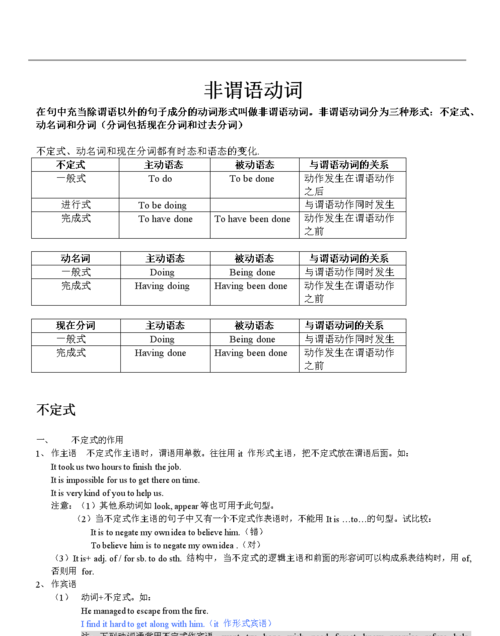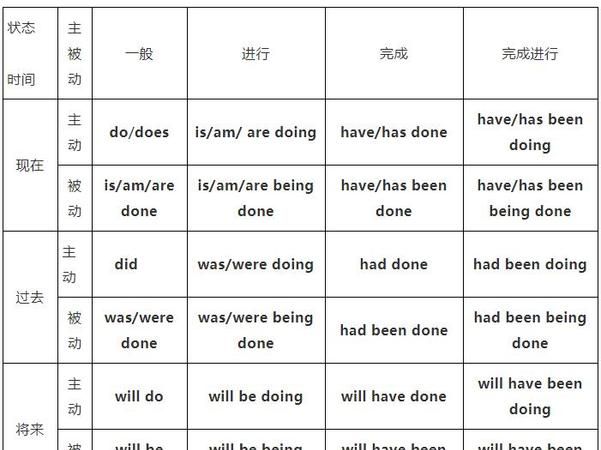本文目录
非谓语动词 不定时和动名词做主语的区别是什么意思
时态选择上有点区别:
1、动名词既可以用于过去的事情,也可以用于现在或将来的事情,如:
Smoking killed him.
Smoking is his only habbit.
Smoking will kill him someday.
2、不定式只能用于表达现在一般状况或将来的情况,不能用于过去,如:
To smoke everyday is a bad habbit.
To smoke at home will bring him trouble.
(错误) To smoke killed him.

非谓语动词不定式和现在分词的区别
区别是:动词不定式是指动词的一种不带词形变化从而不指示人称、数量、时态的形式。它之所以被叫做不定式,是因为动词不被限定,或者说不被词形变化所局限。不定式属于非谓语动词。动词不定式可以作以上各种成分,但它毕竟是动词,所以有动词的属性。动词不定式及其短语还可以有自己的宾语、状语,虽然动词不定式在语法上没有表面上的直接主语,但它表达的意义是动作,这一动作一定由使动者发出。这一使动者称之为逻辑主语。对于英语来说接不定式的单词多为“打算”“计划”“希望”等表示未来的动词。同样与不定时表示不同的动词不定式表示正在进行,一般性或经常发生性的行为。动名词是动词ing形式的一种,兼有动词和名词特征的非限定动词。它可以支配宾语,也能被副词修饰。动名词有时态和语态的变化。英语中的动名词是由动词变化而来,它仍一方面保留着动词的某些特征,具有动词的某些变化形式,用以表达名词所不能表达的较为复杂的意念,另一方面动名词在句子的用法及功能与名词类同:在句子中可以作主语、宾语、表语、定语。它也可以被副词修饰或者用来支配宾语。动名词常泛指,句法作用宾/表/定与主,时态/语态之形式,一般/完成/被动式。Being done 系被动,不含任何进行意。用作主语请留意,常用it作形式主语,不指未来发生事,表达的信息系已知。用作表语请记清,作用相当一名词,检验方法很简单,主与表换位能成立。用作定语也易辩,表示名词之用途。分词就是具有动词及形容词二者特征的词,尤指以-ing或-ed,-d,-t,-en或-n结尾的英语动词性形容词,具有形容词功能,同时又表现各种动词性特点,如时态、语态、带状语性修饰语的性能及带宾词的性能。分词分为现在分词和过去分词两种,是一种非谓语动词形式。现在分词和过去分词主要差别在于:现在分词表示“主动和进行”,过去分词表示“被动和完成”(不及物动词的过去分词不表示被动,只表示完成)。分词可以有自己的状语、宾语或逻辑主语等。一般式doing 一般被动式being done 完成式having done 完成被动式having been done 所有否定式都是在-ing前面加not,过去分词done。

非谓语动词的动词不定式例句
1. "to fly to Beijing to visit her"在本句中是不定式,作plan的宾语。类似plan后面接 to do 作宾语的动词有:
hope, refuse, decide,expect, agree, manage, offer, pretend, promise, plan, afford,
would like/love/prefer等
eg. They hope to findnew resources for mankind.
I want to write to you—but don’t have your address.
2.只接-ing分词作宾语的动词:
admit, allow, imagine, delay, consider, mind, understand, avoid,enjoy, practice, miss, finish, keep, suggest, feel like, cannot stand, put off,keep on, look forward to 等。
eg. I enjoy listeningto music. He often practicesplaying the piano in the evening.
He is fond of playingbasketball. He has given upsmoking.
Would you mind turning down your radio a little,please?
3.可接不定式和-ing分词,且意义变化不大的动词:
love, hate, prefer, begin, ,start,continue等 (dislike, feel like)
Examples::
I like to swim today.
I like swimming verymuch.
I started learning English when I was ten.
It began to rain when I got home last night.
I continue to feel sick.
I hate to see you crying.
4.可接不定式和-ing分词,意义有较大变化的动词:
动词 后接不定式的意思 后接-ing分词时的意思
need 需要做… 需要被…(=need to be done)
want 想要做… 需要被…(=want to be done)
remember 记得要去做… 记得曾做过…
forget 忘记要去做… 忘记曾做过…
regret 很遗憾要做… 后悔做了…
mean 打算/有意做… 意味着…
stop 停下来去做…(另一件事) 停止正在做的事…
try 努力去做… 尝试做…
go on 接着做…(另一件事) 继续做(同一件事) …
eg.He forgot to close the door when he left. (忘了去做某事,to do未发生)
I’ll never forget winning my first gold medal.(忘了做过某事,doing已发生)

非谓语动词 动词不定式的用法 视频讲解
动词不定式:(to)+do,具有名词、形容词、副词的特征.
否定式:not + (to) do
(1)一般式:不定式的一般式所表示的动作与谓语动词动作同时发生或发生在谓语动词动作之后.
例如:
I'm glad to meet you.
He seems to know a lot.
We plan to pay a visit.
He wants to be an artist.
The patient asked to be operated on at once.
The teacher ordered the work to be done.
(2)进行式:不定式的进行式所表示的动作与谓语动词动作同时发生,例如:
The boy pretended to be working hard.
He seems to be reading in his room.
(3)完成式:不定式的完成式表示的动作发生在谓语动词动作之前,例如:
I regretted to have told a lie.
I happened to have seen the film.
He is pleased to have met his friend.
2.不定式的句法功能:
(1)作主语:
To finish the work in ten minutes is very hard.
To lose your heart means failure.
动词不定式短语作主语时,常用it作形式主语,真正的主语不定式置于句后,例如上面两句可用如下形式:
It is very hard to finish the work in ten minutes.
It means failure to lose your heart.
常用句式有:1、It+be+名词+to do。2、It takes sb.+some time+to do。3、It+be+形容词+of sb +to do。4、It+be+形容词+for sb.+to do。常用careless,,clever,good,foolish,honest,kind,lazy,nice,right,silly,stupid,wise,等表示赞扬或批评的形容词,不定式前的sb.可作其逻辑主语。
(2)作表语:
Her job is to clean the hall.
He appears to have caught a cold.
(3)作宾语:
常与不定式做宾语连用的动词有:want, hope, wish, offer, fail, plan, learn, pretend, refuse, manage, help, agree, promise, prefer, 如果不定式(宾语)后面有宾语补足语,则用it作形式宾语,真正的宾语(不定式)后置,放在宾语补足语后面,例如:
Marx found it important to study the situation in Russia.
动词不定式也可充当介词宾语,如:
I have no choice but to stay here.
He did nothing last Sunday but repair his bike.
动词不定式前有时可与疑问词连用,如:
He gave us some advice on how to learn English.
(4)作宾语补足语:
在复合宾语中,动词不定式可充当宾语补足语,如下动词常跟这种复合宾语:want, wish, ask, tell, order, beg, permit, help, advise, persuade, allow, prepare, cause, force, call on, wait for, invite.
此外,介词有时也与这种复合宾语连用,如:
With a lot of work to do, he didn't go to the cinema.
有些动词如make, let, see, watch, hear, feel, have等与不带有to的不定式连用,但改为被动语态时,不定式要加to, 如:
I saw him cross the road.
He was seen to cross the road.
(5)作定语:
动词不定式作定语,放在所修饰的名词或代词后。与所修饰名词有如下关系:
①动宾关系:
I have a meeting to attend.
注意:不定式为不及物动词时,所修饰的名词如果是地点、工具等,应有必要的介词,如:
He found a good house to live in.
The child has nothing to worry about.
What did you open it with?
如果不定式修饰time, place, way,可以省略介词:
He has no place to live.
This is the best way to work out this problem.
如果不定式所修饰名词是不定式动作承受者,不定式可用主动式也可用被动式:
Have you got anything to send?
Have you got anything to be sent?
②说明所修饰名词的内容:
We have made a plan to finish the work.
③被修饰名词是不定式逻辑主语:
He is the first to get here.
(6)作状语:
①表目的:
He worked day and night to get the money.
She sold her hair to buy the watch chain.
注意不定式放句首时,逻辑主语与句子主语要一致:
wrong:To save money, every means has been tried.
right:To save money, he has tried every means.
wrong:To learn English well, a dictionary is needed.
right:To learn English well, he needs a dictionary.
②表结果(往往是与预期愿望相反的结果):
He arrived late only to find the train had gone.
I visited him only to find him out.
③表原因:
They were very sad to hear the news.
④表程度:
It's too dark for us to see anything.
The question is simple for him to answer.
(7)作独立成分:
To tell you the truth, I don't like the way he talked.
(8)不定式的省略:保留to省略do动词。
If you don't want to do it, you don't need to.
(9)不定式的并列:第二个不定式可省略to。
He wished to study medicine and become a doctor.

以上就是关于动词非谓语不定时 ,非谓语动词 不定时和动名词做主语的区别是什么意思的全部内容,以及动词非谓语不定时 的相关内容,希望能够帮到您。
